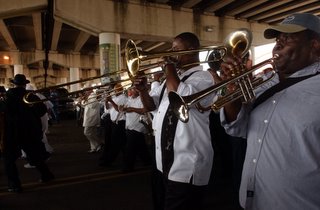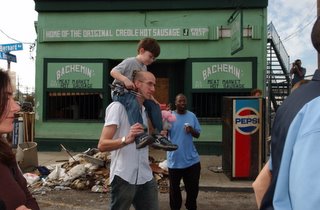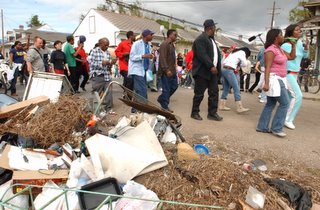I'll Get By, Billie Holiday
Trust me that this will link back to New Orleans.
When I am in a group of people I often do a little census of who's who. Often I focus on race, but sometimes religion, age, and experience come into it. In my Monday night class I may be looking like I am listening to the lecture, but I am doing a mental calculation: 1 African-American woman, 8 Asian American women (maybe 3 Chinese-Americans, 1 Pilipino, & 4 Korean-Americans), 1 woman from Singapore, 15 white females under 30, 5 over 30 (3 of those 5 are over 40), 10 white men, 7 in their twenties, 2 in their middle to late 30s. After I figure out my numbers (guess, really) then I think: who's not here? Why aren't they here? I dunno if other people do this or if it is even P.C. to admit that I do it, but I do. I've done this as long as I can remember. Maybe this is what all admissions deans' daughters do reflexively--calculate the diversity of their lives. I did chose to go to Columbia (and more importantly New York City) based on the "diversity" numbers.
Of course color cannot fully illuminate diversity. Heck, in my little family we have quite a diversity of personalities and needs and wants, but we all look the same or at least similar. Let's say for a minute though that race does indicate diversity.
New Orleans was a diverse place. Before the storm the city was a minority white city. It also does not follow the Northern pattern of segregation. While you would have found all-white and all-black neighborhoods in New Orleans, as I described in my blog yesterday, many of the neighborhoods are more of a checkerboard. A block here is mainly white and the next block in integrated and the next block is mainly black. Black and white people share food stores, restaurants, and clubs.
One of the things that struck me about New Orleans when I arrived was the fact that the city was all of a sudden bleached. White people were everywhere. I felt like I was in Portland, Oregon. In most of the crowds I was in for the first few days, there were usually one or two black people, who seemed to be middle class (based on their dress and body language). I found myself noticing them in a way I usually don’t in New Orleans. The skycaps at the airports were Latino and as we drove down the street I saw lots of Latinos in their cars and truck driving next to me. That’s new. I found myself wondering: Who's not here? Where are they? I felt sad about the Diaspora in a new way. My imagination saw thousands of people stuck in hundreds of new places, strange and daunting, trying to rebuild their lives with no way to get home.
Saturday morning we decided to refresh ourselves by eating what Ramona called “yummy goodness” at Cafe Dumont in the French Quarter. Laura and Mark and our friends Amy and Marlowe and our family all smudged our cheeks and noses with fried dough drowning in powdered sugar. Three of us even partook in two coffees. The blocks and blocks of empty houses were filed away in the back of my mind for the time being. The Mitchell Landrieu, Lt. Governor of Louisiana, and Mary Landrieu’s brother was spotted at a table near us with kids of his own. Sumner danced for the whole patio restaurant on a fountain. Then Ramona climbed up and they goofed around together.

But this was just the beginning. We were going to join up with a second line. Now, before Saturday, the only second lines that I had been a part of were at the weddings of Philip’s friends. At these weddings the bride and groom were given these lacy umbrellas which they poke up and down in the air while marching around the reception site to a fabulous New Orleans brass band. The dancing guests fall in line behind the couple and do an exaggerated march to the brass band’s music.
I think that this is a white man’s second line. A real second line is put on a by a social aide and pleasure club. What I have learned on the internet is that these clubs have an interesting history. Founded in the 1890’s, originally these clubs provided the only source of insurance for Black New Orleaneans. They also paraded around the city in matching colors on Sundays throughout the year and as they could not participate in the white Mardi Gras’s first lines, they marched in back alleys and through their neighborhoods. By the 1940s Northern insurance companies took over the clubs’ financial role, but their folk purpose continues today.
So, Laura and Mark did what they do when they get to New Orleans. They looked into the music that was playing. They read about a Second Line and we wanted to find it. We made our way out of the Quarter towards where we thought it’d be weaving its way through the Bywater and Faubourg Marigny neighborhoods. Laura got a call from an excited 60-something cousin who was with the Second Line on Laura’s recommendation. She told us their location, but they were moving. The kids were tiring, so we stopped at the corner of the Quarter and sent scouts out to find the music. A former neighbor and NOPD member drove by us in her huge SUV and told us she’s find it for us. She came back and directed us one way. We regrouped and headed in the right direction.
When we came upon this Second Line it was like we had just come upon New Orleans as it used to be. Here were the people that had been missing from my daily census reports. And there was music, only-in-New-Orleans music. And there was dancing, only-in-New-Orleans dancing, this sort of march-stomp-sway-bow groove.
It was a really happy place to be. I think New Orleans is going to be okay.
Laura took a lot of pictures, because that's what she does. I think they tell the story a lot better that I can.





















No comments:
Post a Comment